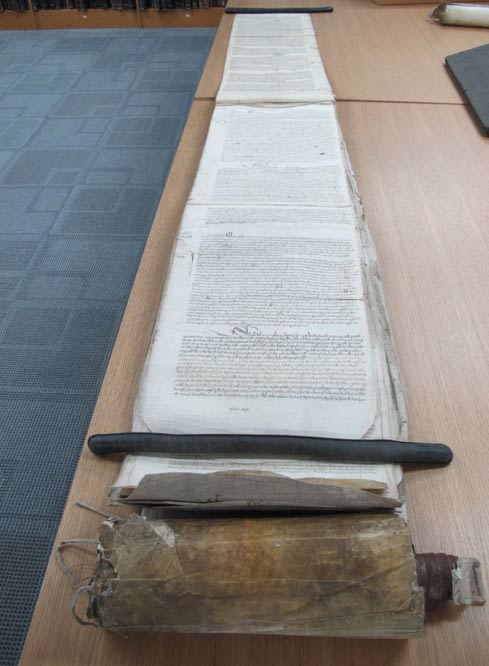
A Timeworn Scroll Reveals King Henry VII’s Interests in New World Colonization
In AD 1499 England launched its very first English-led expedition to "Terra Nova” (New World) and now researchers studying a 16th century scroll have found King Henry VII awarded William Weston, one the explorers, with a handsome paycheck.
While the payment of 30 British pounds sterling could hardly be called a king’s ransom, at that time this was a considerable sum of money; equivalent of a laborers salary for six years, said researchers in a their paper which was published online Oct. 2 in the journal Historical Research. The information was discovered on a huge parchment dating back more than 500 years and ultraviolet light was required to reveal the hidden text said study co-researcher Evan Jones, a senior lecturer in economic and social history at the University of Bristol in a report in Live Science.
Early Transatlantic Rumors
In 2009, the University of Bristol published Jones paper titled The lost voyage: First English-led expedition to North America in which a “long lost letter” written by King Henry VII was addressed to Weston as he “was preparing for an expedition to the new found land.” The king was excited and in support of Weston because in AD 1497 and 1498 the Venetian explorer John Cabot had successfully sailed the Atlantic having set off from the southern English port of Bristol. But it seems Weston was preparing a British-led expedition.

John Cabot in traditional Venetian garb by Giustino Menescardi, 1762. (Public Domain)
“The Cabot Project” is an international project aimed at researching the late 15th and early 16th centuries Transatlantic voyages from Bristol. Margaret Condon of the University of Bristol, who is part of the Cabot Project, researched endless tax records gathering data about the oceanic adventurers traveling to and from North America. These were “written on huge parchment rolls, created from the skin of more than 200 sheep” according to the Live Science article, and each segment on the roll measured “6.5 feet (2 meters) long.”

The telling scroll unravels to 13 foot (4 m). Image: The National Archives, UK.
In the University of Bristol’s statement about the discoveries, Condon said that the rolls were "beasts to deal with, but also precious and irreplaceable documents.” Handling them, she said, “sometimes feels like you're wrestling, very gently, with an obstreperous [boisterous] baby elephant!”
Returning to the main discovery, Henry VII rewarded Weston in January 1498 after they met, and researchers believe “it appears that Weston was likely one of the unnamed “great seamen” from Bristol whom Italian diplomats wrote about during the winter of 1497 to 1498” while describing the Bristol explorers who joined Cabot on his two 1490’s expeditions.
Weston “Was a bit of a Gambler”
Jones also said in the university paper that:
Cabot’s voyages have been famous since Elizabethan times and were used to justify England’s later colonization of North America. But we've never known the identity of his English supporters. Until recently, we didn't even know that there was an expedition in 1499.
Nobody is quite sure how Cabot's last 1498 expedition turned out, but perhaps its ill fate inspired King Henry to send his expedition the following year, led by one of Cabot's deputies, the researchers speculated. Further evidence gathered by members of the Cabot Project revealed that Weston, “Was a bit of a gambler,” said Condon, but “Perhaps you had to be, to risk your life on such a dangerous voyage into unknown seas.”

Map of showing North and South America, or the 'New World'. The map first appeared in Münster's Cosmographia in the 1540s. (Public Domain)
On another level of this fascinating story, the new study also confirmed two extraordinary claims made by Alwyn Ruddock, a deceased historian from the University of London, who having studied the early English voyages to the Americas for over 4 decades claimed that Cabot had explored most of the North American continent’s east coast by AD 1500. Ruddock never published her discoveries and in a bizarre act, upon her death in 2005, she ordered that all her notes were destroyed, and so they were.
- Unmasking King Richard: Does the Lionhearted King of England Have a Better Reputation Than He Deserves?
- Globe on an Ostrich Egg is World’s Oldest Depiction of the New World
- Christopher Columbus: Master Double Agent and Portugal’s 007
These new findings support the two extraordinary claims made by Ruddock who spent over 40 years researching England's first voyages to North America, and although she never published any of her work, she did submit a book synopsis and this was shared with Jones. Ruddock also claimed that a band of Italian friars had sailed with Cabot on his AD 1498 expedition who went on to establish “the first European Christian colony and church in North America” according to an article in Newsweek.
Offering reason as to why the king rewarded Weston, she implied that Weston moved northwards up the Labrador coast searching for the North West passage around the continent and the authors of the latest study suggest it was for this specific reason that Weston was rewarded by Henry.
Top image: Rolled up parchment with information of payment to William Weston from Henry VII. Source: The National Archives, UK















